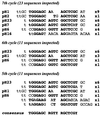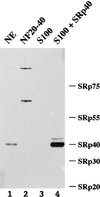Sequence-specific RNA binding by an SR protein requires RS domain phosphorylation: creation of an SRp40-specific splicing enhancer
- PMID: 9037021
- PMCID: PMC19759
- DOI: 10.1073/pnas.94.4.1148
Sequence-specific RNA binding by an SR protein requires RS domain phosphorylation: creation of an SRp40-specific splicing enhancer
Abstract
We showed previously that ASF/SF2, a member of the SR protein family of splicing factors, can activate a splicing enhancer element composed of high-affinity ASF/SF2 binding sites. To determine whether other SR proteins can behave similarly, we selected a high-affinity RNA-binding site (B1) for the SR protein SRp40. Strikingly, the success of this selection was completely dependent on phosphorylation of the RS domain, as unphosphorylated SRp40 failed to select specific sequences. We show that three copies of B1 function as a strong splicing enhancer, activating an intron with suboptimal splicing signals in nuclear extracts. Enhancer activity in S100 extracts (which lack SR proteins) required SRp40 and a nuclear fraction previously found to be required for ASF/SF2-dependent splicing. Importantly, enhancer activity was lost when SRp40 was replaced by ASF/SF2 or SC35, and SRp40 was the only classical SR protein found to be associated with the enhancer. Together, our results indicate that phosphorylation-dependent, sequence-specific RNA binding can impart unique activities to individual SR proteins.
Figures






Similar articles
-
Differential effects of the SR proteins 9G8, SC35, ASF/SF2, and SRp40 on the utilization of the A1 to A5 splicing sites of HIV-1 RNA.J Biol Chem. 2004 Jul 16;279(29):29963-73. doi: 10.1074/jbc.M404452200. Epub 2004 Apr 27. J Biol Chem. 2004. PMID: 15123677
-
The human splicing factors ASF/SF2 and SC35 possess distinct, functionally significant RNA binding specificities.EMBO J. 1995 Jul 17;14(14):3540-51. doi: 10.1002/j.1460-2075.1995.tb07360.x. EMBO J. 1995. PMID: 7543047 Free PMC article.
-
Phosphorylation of the ASF/SF2 RS domain affects both protein-protein and protein-RNA interactions and is necessary for splicing.Genes Dev. 1997 Feb 1;11(3):334-44. doi: 10.1101/gad.11.3.334. Genes Dev. 1997. PMID: 9030686
-
Exonic splicing enhancer-dependent selection of the bovine papillomavirus type 1 nucleotide 3225 3' splice site can be rescued in a cell lacking splicing factor ASF/SF2 through activation of the phosphatidylinositol 3-kinase/Akt pathway.J Virol. 2003 Feb;77(3):2105-15. doi: 10.1128/jvi.77.3.2105-2115.2003. J Virol. 2003. PMID: 12525645 Free PMC article.
-
The splicing factor-associated protein, p32, regulates RNA splicing by inhibiting ASF/SF2 RNA binding and phosphorylation.EMBO J. 1999 Feb 15;18(4):1014-24. doi: 10.1093/emboj/18.4.1014. EMBO J. 1999. PMID: 10022843 Free PMC article.
Cited by
-
Transfer Learning Allows Accurate RBP Target Site Prediction with Limited Sample Sizes.Biology (Basel). 2023 Sep 25;12(10):1276. doi: 10.3390/biology12101276. Biology (Basel). 2023. PMID: 37886986 Free PMC article.
-
Native functions of short tandem repeats.Elife. 2023 Mar 20;12:e84043. doi: 10.7554/eLife.84043. Elife. 2023. PMID: 36940239 Free PMC article.
-
Dysregulation and therapeutic targeting of RNA splicing in cancer.Nat Cancer. 2022 May;3(5):536-546. doi: 10.1038/s43018-022-00384-z. Epub 2022 May 27. Nat Cancer. 2022. PMID: 35624337 Free PMC article. Review.
-
Aberrant RNA splicing and therapeutic opportunities in cancers.Cancer Sci. 2022 Feb;113(2):373-381. doi: 10.1111/cas.15213. Epub 2021 Nov 30. Cancer Sci. 2022. PMID: 34812550 Free PMC article. Review.
-
SRSF5 regulates alternative splicing of DMTF1 pre-mRNA through modulating SF1 binding.RNA Biol. 2021 Oct 15;18(sup1):318-336. doi: 10.1080/15476286.2021.1947644. Epub 2021 Jul 22. RNA Biol. 2021. PMID: 34291726 Free PMC article.
References
Publication types
MeSH terms
Substances
Grants and funding
LinkOut - more resources
Full Text Sources
Research Materials


